Deep Core Muscles: How to Care for Your Psoas
Disclaimer:
The information provided on this blog is for educational and informational purposes only and is not intended as medical advice, diagnosis, or treatment. Always consult with a qualified healthcare professional before attempting any new exercise, movement, or bodywork technique—especially if you have pre-existing injuries, medical conditions, or concerns.
The exercises and recommendations shared here are at your own risk. The author and this blog are not responsible for any injuries, damages, or adverse effects resulting from the use or misuse of the information provided. By voluntarily engaging in any activities mentioned, you assume all risks and agree to release the author from any liability.
What is the “Psoas?”
The “Psoas” is a group of muscles called the Iliopsoas that connect the spine to the lower half of the body. They are essential for walking and are often discussed and treated by bodyworkers, clinicians, and movement practitioners helping people with back and groin pain. The Psoas is the only muscle group that connects the torso directly to the lower limbs; they arguably make up some of the deepest muscles of the core, but are also muscles of the pelvis and inner thigh. Sometimes referred to as the “Seat of the Soul” or the “Fight or Flight” muscle(s) (more on this later), The Psoas is made up of the Iliacus, Psoas Major, and Psoas Minor muscles. The Psoas’ primary function is hip flexion, aka bringing the thigh closer to the torso. When you hinge forward at the hips or lift your leg and begin to take a step, the Psoas, is initiating this movement with the help of a few other muscles. They also aid in other movements when only engaged on either the left or right side of the body – such as side bending at the torso and tilting the pelvis.
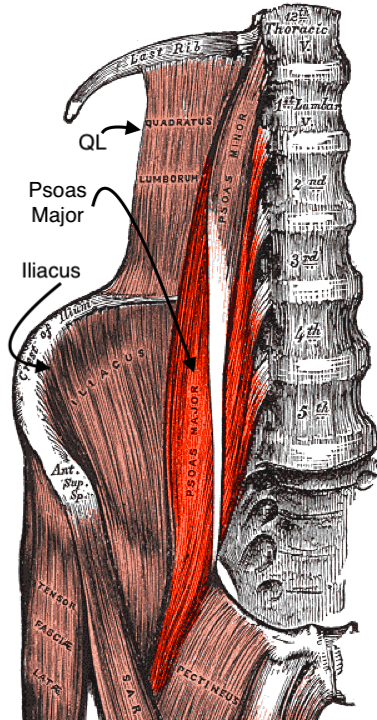


Chronically Tight Psoas? Maybe!
This means, when imbalanced or stuck in spasm in a shortened position, they can cause low back pain, as well as affect the abdomen, groin, inner thigh, pelvis, and even the diaphragm. In a society where many people are sitting all day with their Psoas in a shortened position, this is a region primed for dysfunction. Trigger points in this area can also refer pain to nearby zones (see below). This area of the spine is a region where many nerves emerge at the lumbar nerve plexus that serve the thigh, genitals, gastrointestinal tract, and more. Continue reading below to discover more about these hard-working muscles and how to care for them at home!
Seeking Relief from Low Back Pain?
Ongoing pain in the low back can stem from one or many origins, including muscle tightness or postural imbalances, osteo-related (bone) issueds, urinary & renal dysfunction, reproductive & menstrual causes, digestive causes, and others. This means it’s important to seek the guidance of your primary care physician and specialists when experiencing low-back discomfort, especially for prolonged periods. Due to the deep, postural and locomotive nature of the Psoas, it is common for people to find relief when treating these muscles with bodywork. Our bodies are made for movement. The Psoas is made for movement, which is why it’s so important for folks with sedentary jobs to stand up and move roughly every 20 min.
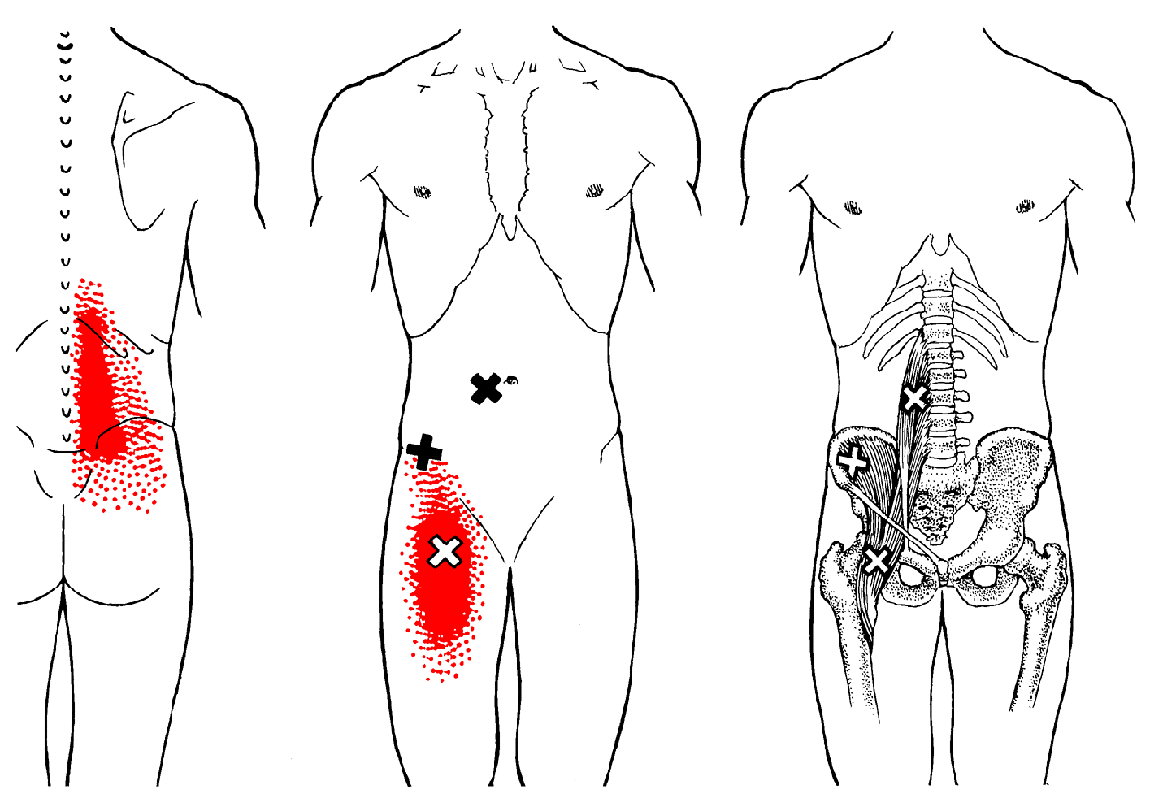
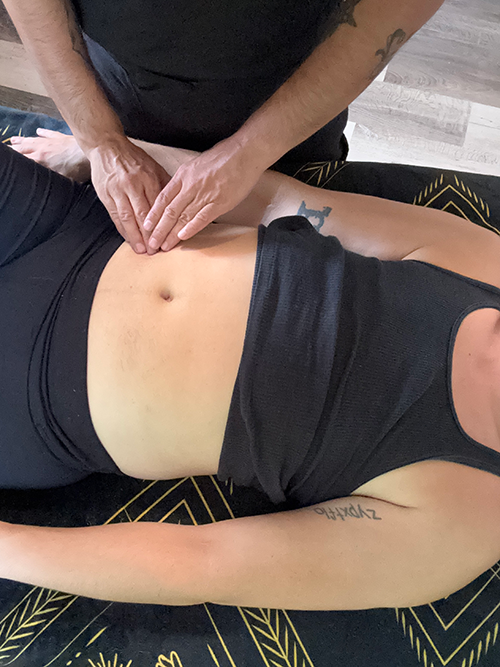
Psoas and Massage Therapy
The Psoas takes patience to reach. Massage of the Psoas requires a slow, gentle approach. It takes trust. It is possible for your massage therapist to access these muscles in order to bring awareness to, lengthen, and/or relax them. Additionally, because the Psoas is connected to the ligaments of the diaphragm it is also common to practice breathwork when engaging with one’s Psoas.
Iliopsoas: Iliacus, Psoas Major & Minor
Function: The Psoas is essential during walking and running due to these muscles helping perform hip flexion. They are also important for sitting & standing, as well as maintaining pelvic tilt and low-back curvature. Fun fact – as babies, when we’re learning to crawl, the curvature of the low back (lumbar spine) and neck (cervical spine) is created by gravity, but as we grow and age, the Psoas Major (and Minor) maintains the curvature of our low back.
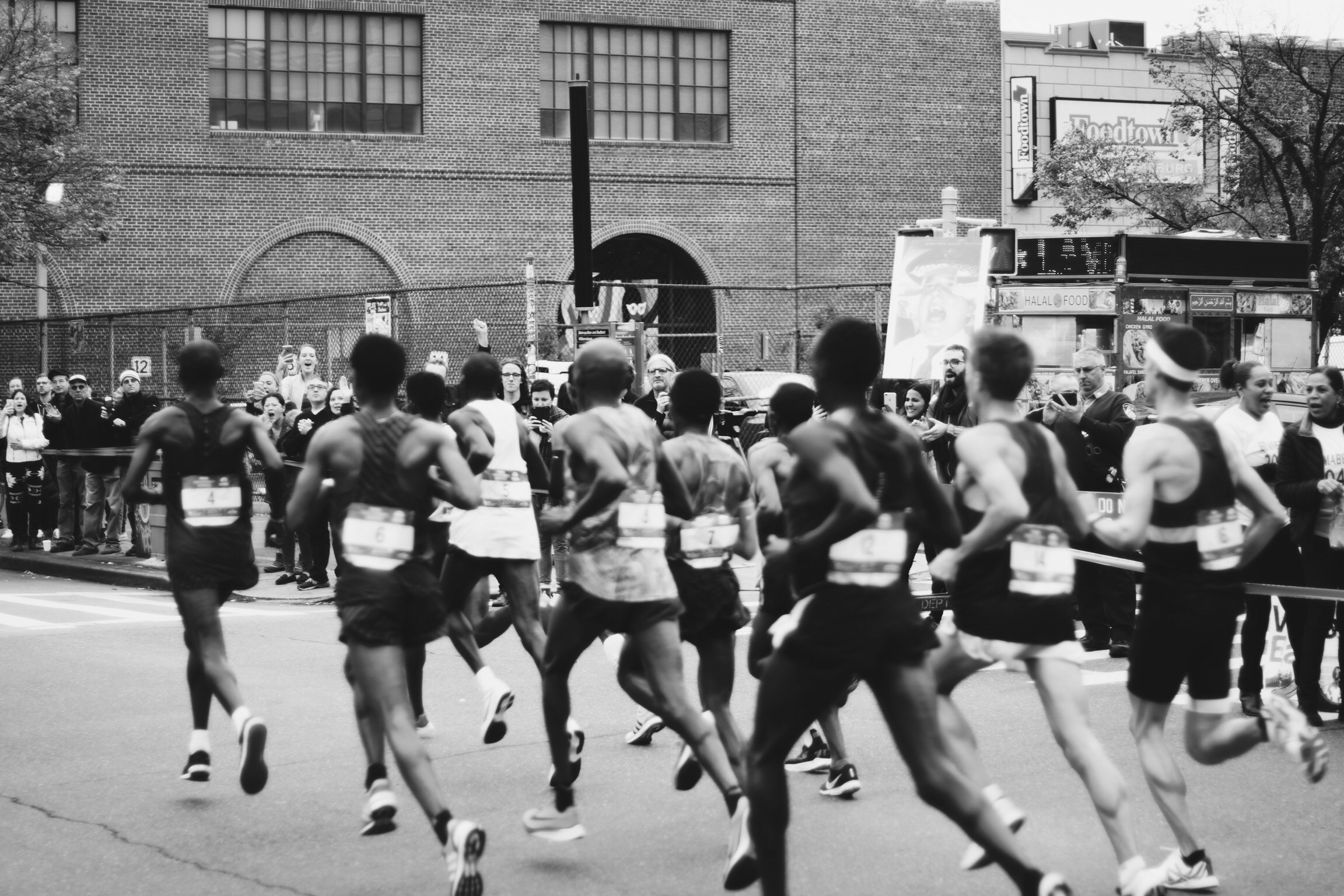
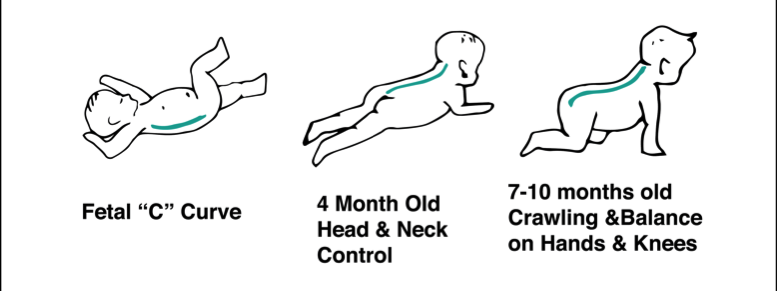
Psoas Major
The Psoas major connects the spine to the lower half of the body. It is wider in the middle and tapers to a point at both ends.
Action: Primarily Hip flexion, as well as maintaining pelvic tilt and side bending.
Origin: Anterior (front) of the Lumbar Spine (L1-L5) and Last Thoracic Vertebra (T12) . Note* T12 is an important junction point for many other muscles!
Insertion: Inner Thigh on the Lesser Trochanter of Femur
When in a shortened state, this muscle can cause the pelvis to tilt forward and down (anterior) – aka stick your booty out. While 10-30° degrees of anterior rotation is normal, when a habitual imbalance occurs, it can create low-back pain and, being that it is essentially at one’s foundation, the pelvis, this can create patterns higher up in the body, such as a head-jutting-forward posture (see figure).
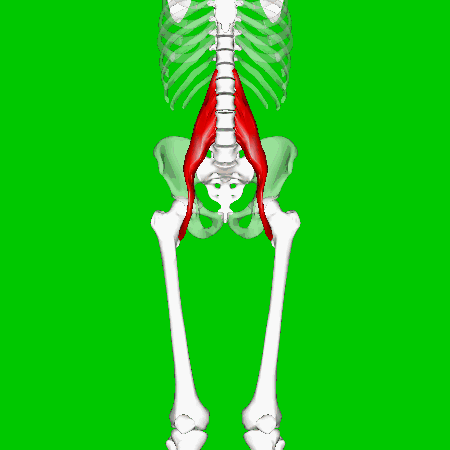
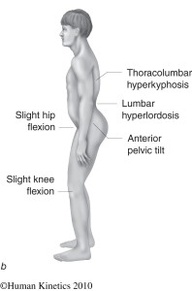
Iliacus
The iliacus muscle is a flat, triangular-shaped muscle, located on the Ilium, or hip bone, in part underneath the Psoas Major & Minor.
Action: Hip flexion
Origin: Iliac Fossa of Hip Bone and Sacrum
Insertion: Inner Thigh on Lesser Trochanter of Femur
It is possible that you can feel this muscle on yourself by placing your hands on your hips.
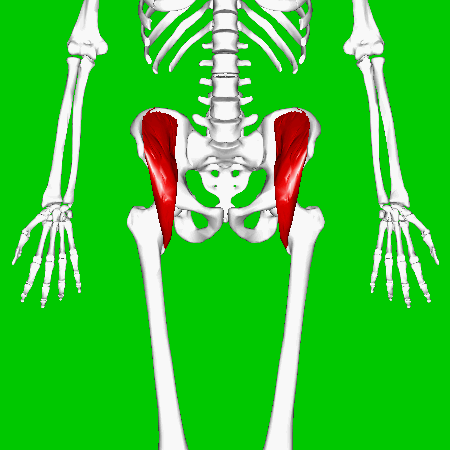
The Seat of the Soul
aka
Fight or Flight Muscle
The Psoas muscles are often referred to as the “Seat of the Soul” or the “Fight or Flight Muscle,” due to the connection with the natural fear response. Whether one quickly hunches over protecting their organs, curls into a fetal position, braces during a fall, or prepares to run away, the Psoas is one of the muscles near our spine and deepest core helping to move into these safety states. When one experiences trauma and is repeatedly in this fear response, with no time to recover and lack of consistent safety, the muscles can begin to remain in spasm, becoming less supple and affecting the health of the tissues nearby such as other muscles, nerves, glands, fascia, gastrointestinal tissues, and more.

Chakras of the Psoas
Because the Psoas originates near the navel and inserts on the upper inner thigh bone, it spans the 1st, 2nd, and 3rd Chakras. To define these concepts effectively would take more than a blog post, but here is an overview: Chakras, which is a Sanskrit word often translated as “wheels,” are a concept from the Yogic tradition that describes several subtle energetic centers that roughly align with the spine. There are commonly 7 Chakras in the Kundalini Yogic tradition, with the general concept being that when these energetic centers are flowing appropriately, our energy is optimized and spiritual awakening and powerful somatic experiences are more possible. The first is the root chakra (“I AM”), which is located near the base of the pelvis. The second is the sacral chakra (“I FEEL”) and the 3rd is the solar plexus chakra (“I DO”). These energetic centers are associated with the gonads, intestines, stomach, liver, adrenals and other abdomino-pelvic structures. As an oversimplification, energetically and emotionally, these chakras are tied to security in the physical world (1st), creativity and sexuality (2nd), and willpower and the action-oriented sense of self (3rd).
Whether looking at the Psoas from a kinesiological perspective or through a more spiritual and ancient energetic lens, it’s easy to see how the Psoas is deeply tied to our emotional well-being. Below are some techniques suited to connecting to this important muscle that does so much for us day-to-day.
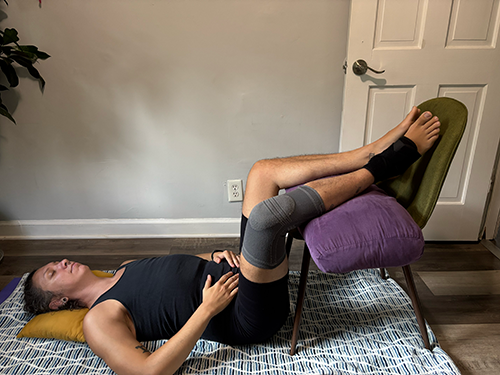
Breathwork for Releasing a Tight Psoas
The Psoas connects to the diaphragm via multiple ligaments and connective tissue, which means one can use deep belly breathing to help effect Psoas function. Every time one inhales, the diaphragm expands, creating an opportunity for the Psoas to lengthen. If one’s breath isn’t flowing, the Psoas could become stuck in spasm. If the Psoas is stuck in spasm, breath may not be inhaled as fully. It’s a cycle.
- In a comfortable seated position, resting both hands on the thighs, begin to undulate your spine, in a snake-like fashion, moving from the tailbone all the way to the top of the head. Move here until ready to move on (1 min+).
- Transition to lying down with knees bent, calves resting on the edge of the couch or piles of pillows. Palms rest on the low belly.
- Easily, begin inhaling, visualizing filling the lungs all the way down to the pelvic bowl. Feel the diaphragm expand into your hands. From there, keep comfortably inhaling – filling the midlung and top of the lungs.
- Then, exhale, visualizing the air leaving your lungs in reverse. Exhale the air from the top of the lungs and all the way to the bottom, feeling your hands and belly slightly fall.
- Without straining, continue to breathe like this for 5 min – working your way up to 30 min in future sessions.
- Take your time sitting up.
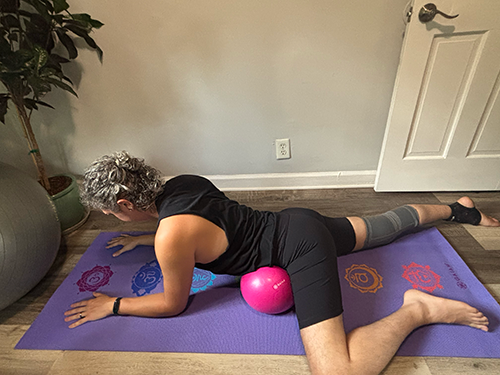
Self-Massage of the Psoas with a Ball
Prop: A soft inflatable ball, roughly 9” Diameter. Popular brands are Yamuna or Coregeous (no affiliation), but you can also find something similar in the toy or fitness department at many stores. The key here is to have the ball partially deflated so that it’s soft enough for a sensitive tummy to roll on.
Why is the Ball Deflated? Safety Precautions with Body Rolling the Psoas
The abdominal aorta, a very large artery, is located along the path of the Psoas, which is why one uses a broad, deflated, squishy ball. Additionally, the Psoas is near the intestines, other organs, and delicate nerve paths. It is NOT advised to use any aggressive techniques on the abdominal area. If you feel a discomfort or a strong pulse while body rolling, take weight off of the ball and shift slightly to either side to move off the aorta. No hard balls or massage guns.
- With your ball handy, begin lying face down on the floor/mat. Note, you may want a pillow or blanket nearby.
- Roll slightly onto one side, bring one leg out to the side like a frog.
- Place the ball below the belly button and just a little off to the side in the direction of the hip.
- Start to very slowly and gently roll forward (in the direction of your head) so that the ball starts to roll down the belly and towards the inner thigh of the bent leg. This could take 3 min. This could take 15 min. Listen to what feels restoring.
- Repeat on the other side.
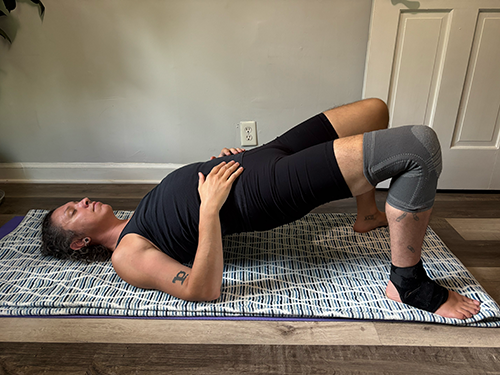
Stretching a Tight Psoas while Strengthening Glutes
In order to stretch the psoas, we need to strengthen the glutes, and one of the most common stretches for lengthening the Psoas is a glute bridge (see below).
- Begin by lying on your back with your knees bent and feet on the floor.
- Push your feet into the floor (not putting any weight in your hands) and extend the hips up, making them as close to flat at the top as you can get.
*Try to move slowly and keep the hips level. *Remember to relax your face. 🙂
3. Repeat 10x Up to 3 Sets 3x/Week
Short Term Relief of Low Back Pain While Sitting
While it doesn’t address the root cause, a simple, temporary aid one can do while sitting, in order to take stress off the low back, is to tie the knees together, therefore stabilizing them. If possible, visualize and encourage the inner thigh muscles and other abdominal muscles to gently engage. When a Psoas is tight, and a pelvis is anteriorly rotated, it causes the legs to rotate outward (laterally). By stabilizing the knees and limiting the outward rotation, the pelvis can tilt slightly posteriorly.
I found this particularly helpful in managing low back pain while rehabilitating from burnout, Long COVID, hypermobile joints, and fibromyalgia.
Up Next
Thanks for reading! Once I began writing and continuing to dive into the Psoas, I realized there was so much I needed to say. In our next muscle deep-dive, we’ll look at the QL or Quadratus Lumborum, which is closely related to the Psoas. Stay tuned!
Contact Moon Massage
Have questions? Get in touch!
booking @ moonmassagetherapy.com
Address
3508 The Plaza
Charlotte, NC 28205
Inside Q Fitness & Wellness